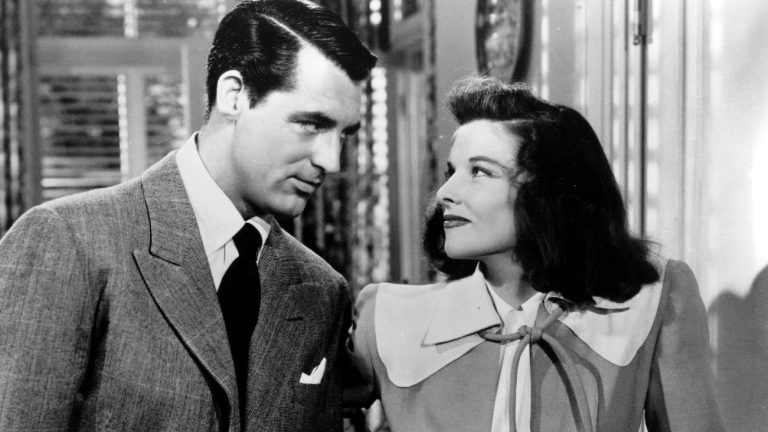The eternal beloved classic, The Philadelphia Story, is one of the greatest fun of all time. Who wouldn’t be enthusiastic about the wildy stylish milieu portrayed in this movie and of this elegant, but biting parade, full of scrapy sense of humor? How’s around this masterpiece and probably the most iconic role of Katharine Hepburn? Bubbles, radiance, history, female connection, whatever.
After a stormy divorce, Tracy Lord prepares for her new wedding to George Kittredge, when the entirely unexpected appearance of her ex-husband, Dexter Haven, thoroughly upsets the schedule. Adding to the complications, the arrival of Macaulay and Liz, journalists from Spy Magazine, mixes up the already upside-down situations and relationships. What is the outcome of these tangles?
One of the most brilliant conversational comedy with screw-ball hittings of course. Stacks of champagne, glittering bubbles, silver promises of moonlight, fabulous craps, slashing social criticism, sharp intellect, loving soul connections, not to mention the all-star-cast! The spirit of the main character, Tracy Lord, the high society’s uncrowned queen, and her divinity of soul and grace, accumlate this story into a radiant female quality – just as the dignity and glory of Katharine Hepburn’s return into her mission.
There is a lot of curiosity about the Philadelphia Story, which is not just a fable, but a rich center of legends, myths, women’s history, business, artistic and social options as well. Initially the play was written as a playwright in the ’30s, especially for stage and theatre, by Philip Barry, a very well-known and qualitative author of the socialite comedies of the ’30s and the ’40s. After its gorgeous and loud succes on Broadway in 1939, numerous adaptation swept through the stages of the USA, from New York to Hollywood. The most popular and perhaps the most outstanding version of these adaptations was the movie, directed by George Cukor, but there is another meaningful production that shouldn’t be ignored either: namely, the Lux Radio Theatre’s broadcast from Hollywood in 1942, with stars such as Cary Grant and James Stewart.
Philip Barry’s plays have a very unique sense of humor and perspective, usually close to British and French points of views. The author’s main strength is probably the his way of looking at and portraying high society, a sharply ironic and critical, but empathetic attitude. His stories are full of diversity, deeply human characters, and not just ’models’ or ’statues’, as n the case of Holidayor The Philadelphia Story.
The Philadelphia Story premiered in New York on the 28th March 1939. The Shubert Theatre production featured great actors and actresses, such as Katharine Hepburn, Joseph Cotten, Van Helfin, Frank Fenton, Lenore Lonergan or young Vera Allen. The story was inspired of real impressions. The socialite character, Tracy Lord, was inspired by Helen Hope Montgomery Scott, a Philadelphian socialite woman, who was on good terms with Philip Barry, the author. A good friend of Barry’s was the husband of Helen Hope Montgomery, the ’unofficial queen of Philadelphia’s WASP oligarchy’. She was said to be like just as Tracy in the story, and there was a strange analogy between Hepburn’s and Montgomery’s attitudes.

The performance was a remarkable and significant Broadway hit and a glorious, worthy comeback for Katharine Hepburn, after the period of being considered ’box office poison’ and after personal life crisis. Hard times came for Katharine Hepburn after harsh recepcion of The Lake (1933). Written by Dorothy Massingham and Murray MacDonald and produced by the ruthless shark of theatrical world of the time, Jed Harris, The Lake was an important show on Broadway, but because of some unpleasant personal background, the press communications were very confused and judgmental.
It took years for Katharine Hepburn’s career to make a worthy and distinguished comeback. Before the Philadelphia Story, the actress appeared several times on Broadway, for example in A Month in the Country (1930), Holiday (1928) and The Warior’s Husband (1932), but this performance was her real manifestation of the intense, divine, well-knit iconography of her presence, full of wit, independence, elegance, forthwright, mystic and at the same time very clean and natural. She didn’t play Tracy Lord, but she lived it.
There is an interesting thing around the play, that might raise questions. The Philadelphia Story, with its lovely upside-down affairs, and a feminist character at the center with three guys around her, premiered in New York in 1939. A sparkling West End social comedy, While the Sun Shines, written by the great British playwright, Terence Rattigan, opened in London in 1943. Rattigan’s story set in a dense historical atmosphere of the Second World War, revolves around Lady Elizabeth, a woman much like Tracy Lord, with a British sailor, an American aviator, and a free-spirited French civil servant. Gentleman, ’who’s afraid of Virginia Woolf’?








